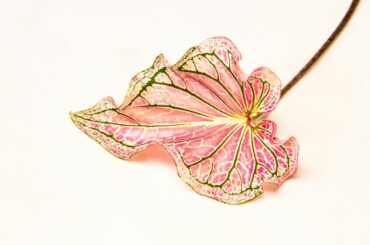We all love to see healthy zucchini plants. Healthy zucchini leaves are bright green because they use chlorophyll to produce food for the plant through photosynthesis. If your zucchini leaves turning brown, there are a few reasons for this problem
It’s likely due to a lack of water, too much water, a pest infestation, or a disease. Here I have listed seven main reasons for brown leaves on zucchini plants and how you can fix the problem.
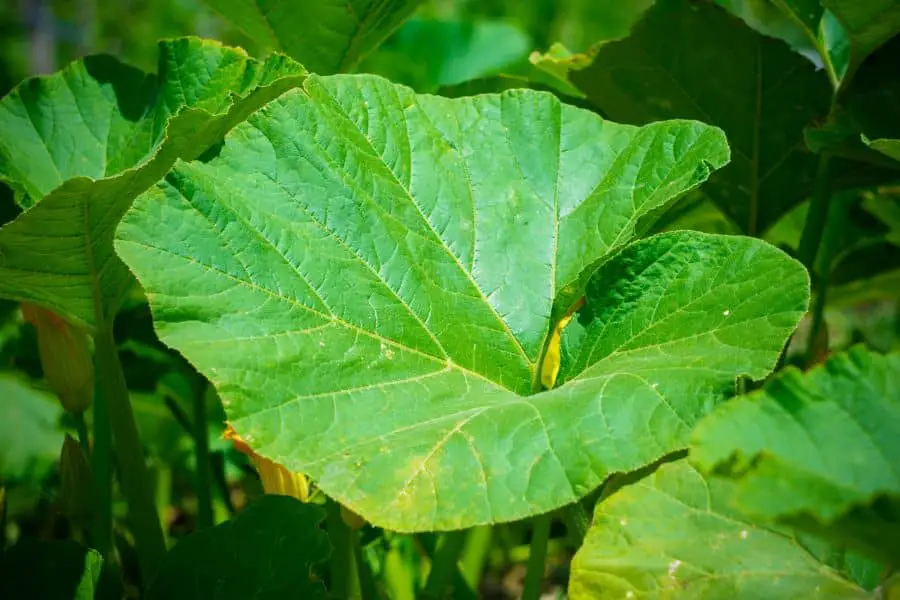
Why Are My Zucchini Leaves Turning Brown + Solutions?
There are mainly seven reasons why zucchini leaves turn brown.
1. Not Getting Enough Sunlight
Like any other squash, zucchini requires full sun to produce optimally. Zucchini needs at least 6 hours of sunlight per day. If your zucchini plants are not getting enough sun, the leaves will start to turn yellow, then brown, and the plant will produce less fruit.
Solution: Move your zucchini plants to a sunnier location. If you’ve grown your zucchini in a pot, this is a simple task. But if they are in the ground, you will need to transplant them.
Things to remember: Since zucchini is an annual plant, it is normal for the plant to go dormant and die after it has produced fruit. So, if you see the leaves turning brown in the fall, it is not necessarily a problem.
2. Overwatering
Zucchini plants require approximately 1 inch of water per week. If you water them more than that, the roots will start to rot, and the leaves will turn brown and wilt. Additionally, the leaves of the plant may become infected with fungal diseases (I will explain later) due to high humidity.
Solution: Water your zucchini plants only when the soil is dry. One way to test this is to stick your finger in the soil. If it feels moist, then you don’t need to water it yet. Further, water only the base of the plant and not the leaves to avoid fungal diseases.
You can also avoid overwatering by mixing airy soil like compost and sand with heavy soil. This will allow the water to drain more effectively.
Things to remember: Water in the morning so that the leaves have time to dry before nightfall. Further, if you have planted zucchini in sandy soil, you may need to water more frequently as sand drains quickly.
If the soil is heavy and drains slowly, you may need to water less often as the roots could rot in soggy soil. If zucchinis are growing in a pot, ensure that the pot has drainage holes at the bottom.
3. Underwatering
If you don’t water your zucchini plants enough, the leaves will start to turn brown and wilt. This is because the plant is not getting enough moisture, and the leaves are drying out.
Solution: Water your zucchini plants more frequently, making sure that the soil is moist but not soggy. One way to test this is to stick your finger in the soil. If it feels dry, then water the plant. You can also use mulch to maintain the moisture in the soil around the plant.
Things to remember: Zucchini plants need about 1 inch of water per week.
If you grow zucchini in a pot, make sure to check the soil more frequently, as pots dry out quickly. Do not overwater your dehydrated zucchini plants at once, as this may shock the plant and cause the leaves to turn brown due to overwatering. Instead, water slowly and deeply so that the water can reach the roots. As a result, there is little you can do to save your plants other than provide adequate water and nutrients.
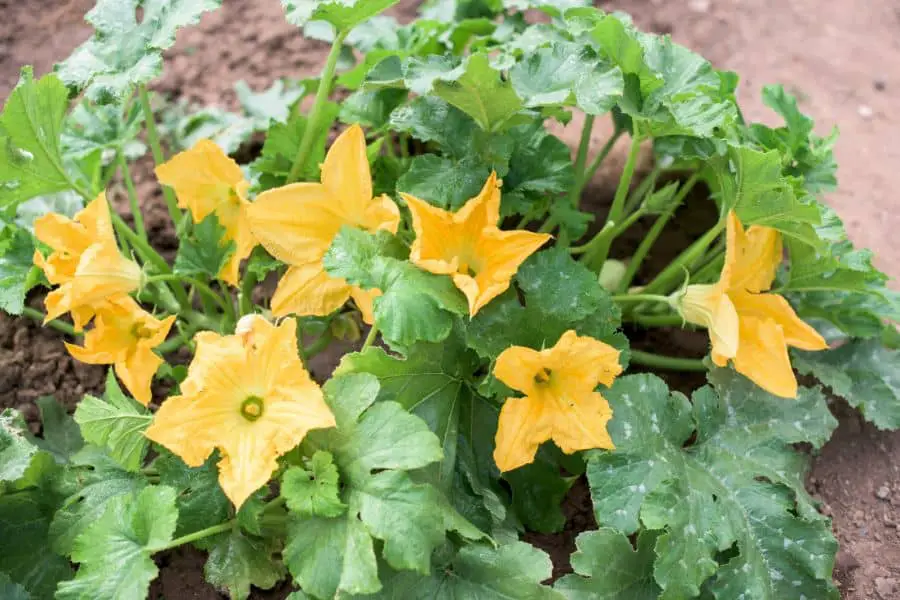
4. Damaged Roots
If the roots of your zucchini plants are damaged, it will affect the plant’s ability to absorb water and nutrients, resulting in the leaves turning brown. Roots can be damaged by things like pests, herbicides, transplanting, or heavy machinery.
Solution: If you suspect that the roots are damaged, gently dig up the plant to check. If the zucchini roots are damaged, you will need to replant the zucchini in new soil. Further, you will have to cut off dried leaves and stems to prevent the spread of disease.
Things to remember: Zucchini plants are sensitive to root damage, so be careful when transplanting or handling the plant. Most of the time, it is not possible to save a plant with damaged roots.
5. Nutrient Deficiencies
Zucchini plants can suffer from nutrient deficiencies, which can cause the leaves to turn brown. The most common nutrients that zucchini plants need are nitrogen, phosphorus, potassium, calcium, iron, magnesium, manganese, sulfur, and zinc. Among these, nitrogen, potassium, sulfur, magnesium, and iron are needed for the plant to produce chlorophyll, which gives the leaves their green color. A lack of these nutrients will lead to the yellowing of the leaves, followed by browning.
In addition, when there is an abundance of calcium, manganese, phosphorous, copper, potassium, or zinc in the soil, it causes the iron to bind and become inaccessible to plants. This will also cause the leaves to turn yellow and then brown.
Solution: The best way to solve nutrient deficiencies is by getting a soil test done. This will help you identify which nutrients are lacking in the soil. Once you know this, you can add the appropriate fertilizer to the soil.
You can also fix nutrient deficiencies by mixing compost or well-rotted manure. This organic matter will help to improve the quality of the soil and provide the plant with the necessary nutrients.
Things to remember:
- Zucchini plants need to be fertilized every 2-3 weeks.
- When using chemical fertilizers, make sure to follow the directions on the package.
- If you are using organic fertilizer, make sure that it is well-rotted and mixed into the soil before planting.
If you’re looking to give your zucchinis a boost and are dealing with iron deficiencies, chicken or horse manure is much more effective than cow manure. Cow manure is high in phosphorous, which can actually aggravate the problem.
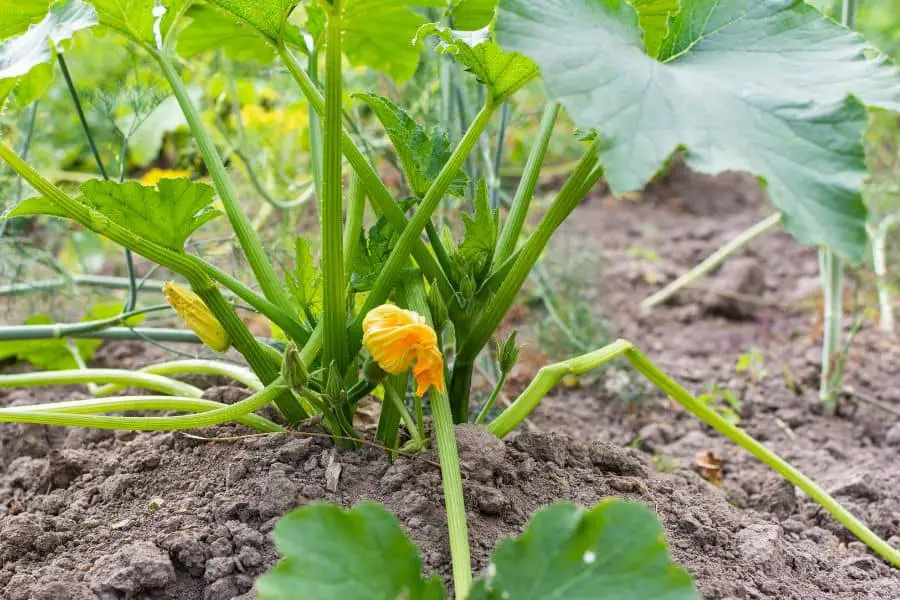
6. Disease
There are several diseases that can infect zucchini. Among those, there are five well-known diseases that can cause brown leaves:
Powdery Mildew:
This is a fungal infection that appears on the leaves as white or gray powdery spots. It usually affects the upper surface of the leaves first but can eventually spread to the undersides as well.
Solution: You can prevent powdery mildew by planting disease-resistant varieties. You should also stop overhead watering, as this can help the fungus spread.
If your plant is already contaminated, you can try spraying the leaves with a solution of water and baking soda to control it. You can also use milk spray, which has been shown to be effective in controlling powdery mildew.
Things to remember:
- Powdery mildew is a common disease that can affect zucchini plants.
- It is important to control this disease early, as it can spread quickly and severely damage the plant.
- Powdery mildew is prevalent in late summer and early fall when the environment is warm and humid.
Downy Mildew:
This is another fungal infection that appears as yellow or brown spots on the bottom side of the leaves. The spots will eventually turn brown, and the leaves will wilt and die.
Solution: You can prevent downy mildew by planting disease-resistant varieties. You should also stop overhead watering, as this can promote the spread of the fungus.
If your plant is already damaged, you can treat the condition by using a mixture of hydrogen peroxide and baking soda. This will aid in limiting the spread of the fungus.
Things to remember:
- Downy mildew is a common disease that can affect zucchini in cold, wet weather.
- It is important to control this disease early, as it can spread quickly and severely damage the plant.
Anthracnose:
This is a fungal disease that appears as small brown or black spots on the leaves. The spots will eventually turn into lesions, and the leaves will die. The plant will eventually die.
Solution: Unfortunately, you won’t be able to save your plants. The best course of action is to remove and discard the infected plant. This will prevent the spread of this disease.
You can also try treating the infected zucchini plant with a copper- or sulfur-based fungicide every 7–10 days. But the plant is likely to die.
Things to remember:
- Anthracnose is a serious disease that can kill zucchini plants. It is more common in highly humid conditions and during rainy periods.
- Removing and discarding any infected plants to prevent the spread of this disease is important.
Bacterial Wilt:
This is a bacterial infection that causes the leaves to wilt and die. The plant will eventually die. The disease is spread by both varieties of cucumber beetles.
Solution: Unfortunately, there isn’t much you can do to save your plants. Remove and dispose of the infected plant to prevent the spread of this disease.
Do not try to compost or rot the infected plant, as this will only spread the disease.
Things to remember:
- Bacterial wilt is a serious disease that can kill zucchini plants.
- It is spread by cucumber beetles and can quickly kill a plant.
- Weeds can be hosts to cucumber beetle larvae, so it is important to keep your garden free of weeds.
Fusarium wilt:
This is a fungal disease that causes the leaves to wilt and die. Fungal spores may be carried by cucumber beetles and are present in the soil. The plant will eventually perish.
Solution: Unfortunately, there isn’t much you can do to save your plants. Remove and discard the infected plant immediately to prevent the spread of this disease.
Do not try to compost or rot the infected plant, as this will only spread the disease.
Fungicides do not work once the plant is infected, so there is no treatment.
You can prevent the disease by planting disease-resistant varieties and keeping your garden free of cucumber beetles.
Things to remember:
- Fusarium wilt is a serious disease that can kill zucchini plants.
- It is spread by cucumber beetles and can quickly kill a plant.
- Weeds can be hosts to cucumber beetle larvae, so it is important to keep your garden free of weeds.
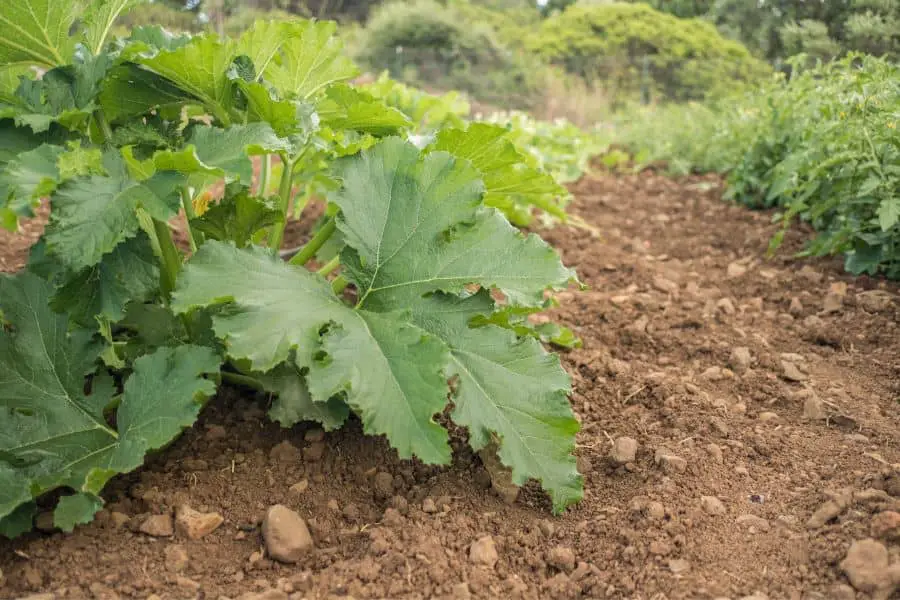
7. Pest Infestations
Although many different pests can infest zucchini plants, cucumber beetles, squash bugs, and spider mites are the most common pests that can cause the leaves to turn brown.
Cucumber Beetles:
These are small, striped beetles that are yellow or orange in color. These pests can be hosts to several diseases, such as bacterial wilt and fusarium wilt. They will also eat the leaves of the plant, which can weaken it.
Solution: The best way to control cucumber beetles is to use a pesticide. You can also try to pick them off by hand, but this is not always effective.
If you have a serious infestation, you may need to destroy the plant.
Things to remember:
- Cucumber beetles are one of the most common pests that attack zucchini plants.
- They can spread disease and damage the plant.
- Pesticides are the most effective way to control them.
- You can control the population by removing weeds, which can be hosts to cucumber beetle larvae.
Squash Bugs:
These are dark brown or black bugs that feast on the leaves of squash plants. They can cause the plant’s leaves to turn yellow and brown, eventually killing it.
Solution: The best way to control squash bugs is to use an insecticide. You can also try to pick them off by hand, but this is not always effective.
If the infestation is severe, you may have to destroy the plant.
Things to remember:
- Squash bugs are one of the most common pests that attack zucchini plants.
- They can spread disease and damage the plant.
- Pesticides are the most effective way to control them.
- You can control the population by removing weeds, which can be hosts for squash bug larvae.
Spider Mites:
These tiny spider-like pests suck the sap from the leaves of the plant, causing them to turn yellow and brown. A heavy infestation can kill the plant.
Solution: The best way to control spider mites is to use an insecticide. Both ladybugs and lacewings enjoy dining on mites. So, you can also try releasing these beneficial insects into your garden.
Things to remember:
- You can control most of these pests with companion planting.
- Nasturtiums, marigolds, and petunias are good pest deterrents.
- You can also try to pick them off by hand, but this is not always effective.
- If you have a severe infestation, you may have to destroy the plant.
Final Words
The best way to prevent zucchini leaves turning brown is to practice good garden hygiene and keep an eye out for pests. If you do find pests, be sure to control them immediately. If the leaves are already brown, there is not much you can do except remove the plant and hope that your other plants are not affected.
Read Next : Do Mice Eat Basil Plants? ( Better Explanation )
Read Next : Do Rose Of Sharon Like Coffee Grounds? (Pros & Cons)
Read Next : Onion Seedlings Falling Over | Easy Solution |


